At the beginning of this month, the Syrian regime’s media started to report about the return of displaced Syrians to their homes in the countryside of Albu Kamal in the Deir Ezzor province. SANA agency published a number of photos of the returnees to the area with a comment about “the return of dozens of displaced families to their towns and villages liberated from terrorism in the south-eastern countryside of Deir Ezzor,” while another report hailed the return as an initiative of “the Deir Ezzor branch of the Arab Socialist Ba’ath Party, which provided buses to citizens wishing to return to their villages from other governorates free of charge.”
What the regime’s media did not mention is that the number of people who returned constitutes less than 10% of the population of the area, most of whom were displaced during previous years. In fact, these reports significantly distorted the truth by highlighting a small number of returnees while concealing the fact that the huge majority of the region’s population cannot return because the regime’s ongoing security policy of violently targeting the residents of the region and returnees in general.
Khattab Al-Awad, a member of the Syrian Association for Citizens’ Dignity from Albu Kamal, explains the recent cases of return promoted by the regime media: “Most of these returnees were displaced in Damascus and returned because they could not afford the living costs and were being harassed. They were also affected by the efforts of people working on “reconciliation” inside and outside the regime-controlled areas, including some sheikhs and dignitaries.” The dangers facing returnees to regime areas are great, says Al-Awad. “I know a good number of people who returned to the regime-held areas after their livelihoods narrowed and it became difficult to secure housing and shelter for their family in displacement. Upon their return and the initial “welcome” by the regime, the recruitment of young men began by the Iranian militia operating in the area, or the regime’s army. If they refused, they would be arrested. There were many such cases of arrest, and also cases of killings and liquidations of some of the returnees by the members of the regime and militias, but also by unknown assailants. I know families who had to flee the regime-held areas after their return.”
What Al-Awad is describing is the “return” as implemented by the Syrian regime. Not all the displaced people of the region are allowed to return, but only some who were internally displaced to the regime-held areas, such as, in this case, countryside of Deir Ezzor , Damascus, or the Coastal region. The rapidly deteriorating living conditions in these areas were the main motivation for their return despite the bad security situation in the places they return to.
Fear of arrest and liquidation
It is important to remind of the reasons people fled their homes in the first place, which put any possibility of return into a proper context. Fares Alaswad, illustrates the situation facing most of the people displaced from this area: “I was first displaced by the regime from the city of Deir Ezzor in 2012 and then to Turkey in 2015. I cannot return because I am wanted by the regime. Even my children could not obtain passports because I am wanted by the regime. It is impossible for me to return, because I will be arrested upon my return, while at the same time my house is occupied by the National Defense Militia, which prevented my relatives from even entering it.” When asked about the possibility of returning through a “reconciliation” process with the regime, Alaswad is adamant: “Of course I do not trust reconciliation with the regime. There are no guarantees that would make me trust the regime, because I heard about people who went through reconciliation who have been arrested or blackmailed for huge sums of money after being threatened with arrest. In addition, there is no safe return with the presence of so many militias who are not subject to any law or control. There are several centers of power in the area, each acting according to their own whim and law. Under such circumstances, the numbers of people who are able to return, if any, are very, very small.”
This confirms one of the main findings of the “We Are Syria” report, the latest SACD survey of some 1,100 displaced people, that 90% of the study participants believe that their feeling of insecurity was the main reason for their displacement. This highlights the importance of the security situation for the displaced Syrians, especially regarding their decision to return to their areas. Dr. Muhammad Suleiman, a member of the Syrian Association for Citizen Dignity from Deir Ezzor, explains: “The biggest danger for me and my family is arrest by the regime or its allies who operate in the region, perhaps even my liquidation. I have some acquaintances whose situation in Lebanon and Jordan really worsened and they returned to Deir Ezzor and its countryside, but after a very short time they left for Turkey and from there to Europe with the help of smugglers.” Dr. Suleiman’s description reflects one of the key findings from the SACD report “Revenge, Repression and Fear: The Reality Behind Assad’s Promises to Syrian Refugees and Displaced Persons” , issued in October 2019. This report surveyed the conditions of Syrians and displaced persons in the Assad regime-controlled areas and found 60% of those interviewed (and 73% of those living in areas that the regime has taken over by force) were seriously considering leaving again if they had the opportunity.
The fact that security conditions for the return of the majority of displaced people from Deir Ezzor simply do not exist is confirmed by all the displaced people from these areas we spoke to, especially those who reside in the countries of the European Union. M.K., a refugee from Deir Ezzor who is currently residing in Germany says: “Of course, returning to regime-held areas has become impossible in light of the current conditions. My husband was prominently against the regime. Our house has been taken by the regime and we would be arrested as soon as we step into Assad-control areas. Also, I know of my husband’s nephew who made reconciliation so that he could complete his education, but security arrested him after a short period and his fate is still unknown. After this situation my fear of the regime and the arrest increased, and I learned that there are no real guarantees for anyone who returns. No returnee is safe from this criminal regime.” A.A. from Al-Mayadeen, seconds this sentiment: “I cannot return because of my fear of arrest, kidnapping or recruitment with militias there. I know a lot of such cases, including a man who defected from the military and was forced to return. He was killed in prison. A doctor I know was imprisoned and paid a large sum of money to be let out. Even the small number of people who returned from Damascus, they all fear for their families, not to mention the lack of basic services, especially medical and education.”
Rukban model of “return”
These testimonies paint a grim picture, which was seen elsewhere. the return of some families to Deir Ezzor hailed by the regime is easily comparable to the model of “safe and voluntary” return that the regime and its Russian allies promoted for the residents of al-Rukban camp. When a small number of camp residents, who were starved into returning in December 2019, a number of them were arrested, and the fate of a many of them still remains unknown. Just as the Deir Ezzor families, they originally obtained permits and guarantees from the regime and Russia not to be harmed, yet were immediately arrested and transferred to “terrorism courts.”
“Some of the families who returned these days were internally displaced in the areas of Damascus, the Coastal region and Homs and were under pressure since 2017 to return to the areas under the control of the Iranian militias and the regime’s army west of the Euphrates River. We now see that these militias have the power to allow the planning of whom the Syrian regime will allow to return to their areas,” says Dr. Suleiman.
Yet, even a superficial assessment of the security situation in Deir Ezzor and the area where the regime’s media celebrated the return of the displaced, shows that these militias are the main source of insecurity and danger to the returnees. The Furat Press Agency in April reported a massacre of a number of civlians in Deir Ezzor by militia members. The agency reported that armed men belonging to the Afghan “Fatemiyoun” militia, and members of the tribal army militia (National Defense), attacked a number of civilian families who graze sheep in the Badia near the village of Ma’dan Ateeq. They arrested scores or men who were later all found shot in the head, handcuffed. Their tents were burned.” This crime by the regime’s allies is but one illustration of the awful security situation in the region, which runs directly counter the fictitious stories of “return of the displaced” churned out by the regime’s propaganda machine.
This raises the question of why did this “return” happen now and was so prominently hailed by the regime’s media. One possible answer could be related to the conference on the return of Syrian refugees which is being organized in part by the Russian Ministry of Defense in Damascus on 10-14 November..
The examples of such “voluntary return” are presented by the regime’s propaganda to show how the areas under its control have become “safe” and that the displaced have begun to return. The sole purpose of such propaganda is to relieve international pressure on the regime, while the reality on the ground clearly shows that the security situation for the returnees and people from the so-called “reconciliation areas” is not only awful, but is progressively getting worse with the ongoing repression intensifying.
Lastly, examples such as this from Deir Ezzor speak of another crucial element in any discussion on the safe, voluntary and dignified return: as our “We Are Syria” report documents, the vast majority of displaced Syrians want to see and organised, collective return with a comprehensive political agreement guaranteeing their rights under robust international guarantees. These sporadic cases of “return” in fact testify to exactly the opposite policy on return implemented by the Syrian regime and its Russian and Iranian allies – they are not interested in the return of large numbers of displaced Syrians in a safe, and dignified way, but will proceed with allowing a trickle of “approved” people to return into the insecurity and lawlessness that reign in the areas under the regime’s control. The impact of such policies is today clearly evident as there are still more than double the number of Syrians being internally displaced than those who are returning back to their original areas. No amount of regime’s propaganda and Russian conferences on return will change the grim reality facing the Syrians in regime-held areas, as Deir Ezzor case clearly testifies.



